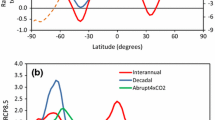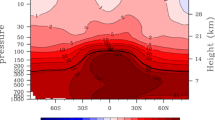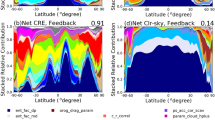Abstract
Global and local feedback analysis techniques have been applied to two ensembles of mixed layer equilibrium CO2 doubling climate change experiments, from the CFMIP (Cloud Feedback Model Intercomparison Project) and QUMP (Quantifying Uncertainty in Model Predictions) projects. Neither of these new ensembles shows evidence of a statistically significant change in the ensemble mean or variance in global mean climate sensitivity when compared with the results from the mixed layer models quoted in the Third Assessment Report of the IPCC. Global mean feedback analysis of these two ensembles confirms the large contribution made by inter-model differences in cloud feedbacks to those in climate sensitivity in earlier studies; net cloud feedbacks are responsible for 66% of the inter-model variance in the total feedback in the CFMIP ensemble and 85% in the QUMP ensemble. The ensemble mean global feedback components are all statistically indistinguishable between the two ensembles, except for the clear-sky shortwave feedback which is stronger in the CFMIP ensemble. While ensemble variances of the shortwave cloud feedback and both clear-sky feedback terms are larger in CFMIP, there is considerable overlap in the cloud feedback ranges; QUMP spans 80% or more of the CFMIP ranges in longwave and shortwave cloud feedback. We introduce a local cloud feedback classification system which distinguishes different types of cloud feedbacks on the basis of the relative strengths of their longwave and shortwave components, and interpret these in terms of responses of different cloud types diagnosed by the International Satellite Cloud Climatology Project simulator. In the CFMIP ensemble, areas where low-top cloud changes constitute the largest cloud response are responsible for 59% of the contribution from cloud feedback to the variance in the total feedback. A similar figure is found for the QUMP ensemble. Areas of positive low cloud feedback (associated with reductions in low level cloud amount) contribute most to this figure in the CFMIP ensemble, while areas of negative cloud feedback (associated with increases in low level cloud amount and optical thickness) contribute most in QUMP. Classes associated with high-top cloud feedbacks are responsible for 33 and 20% of the cloud feedback contribution in CFMIP and QUMP, respectively, while classes where no particular cloud type stands out are responsible for 8 and 21%.









Similar content being viewed by others
References
Andronova NG, Rozanov EV, Yang F, Schlesinger ME, Stenchikov GL (1999) Radiative forcing by volcanic aerosols from 1850 through 1994. J Geophys Res 104:807–816
Boer GJ, Yu B (2003) Climate sensitivity and response. Clim Dyn 20:415–429
Bony S, Dufresne J-L (2005) Marine boundary layer clouds at the heart of tropical cloud feedback uncertainties in climate models. Geophys Res Lett 32:L20806. DOI 10.1029/2005GL023851
Bony S, Emanuel KA (2001) A parameterization of the cloudiness associated with cumulus convection; evaluation using TOGA COARE data. J Atmos Sci 58:3158–3183
Bony S, Dufresne JL, Le Treut H, Morcrette JJ, Senior CA (2004) On dynamic and thermodynamic components of cloud changes. Clim Dyn 22:71–86 DOI 10.1007/s00382-003-0369-6
Cess RD, Potter GL (1988) A methodology for understanding and intercomparing atmospheric climate feedback processes in general circulation models. J Geophys Res 93:8305–8314
Cess RD, Potter GL, Blanchet JP, Boer GJ, Del Genio AD, Deque M, Dymnikov V, Galin V, Gates WL, Ghan SJ, Kiehl JT, Lacis AA, Le Treut H, Li ZX, Liang XZ, Macavaney BJ, Meleshko VP, Mitchell JFB, Morcrette J-J, Randall DA, Rikus L, Roeckner E, Royer JF, Schelse U, Scheinin DA, Slingo A, Sokolov AP, Taylor KE, Washington WM, Wetherald RT, Yagai I, Zhang MH (1990) Intercomparison and interpretation of climate feedback processes in 19 atmospheric general circulation models. J Geophys Res 95:16601–16615
Cess RD, Zhang MH, Ingram WJ, Potter GL, Alekseev V, Barker HW, Cohen-Solal E, Colman RA, Dazlich DA, Del Genio AD, Dix MR, Dymnikov V, Esch M, Fowler LD, Fraser JR, Galin V, Gates WL, Hack JJ, Kiehl JT, Treut HL, Lo KKW, McAvaney BJ, Meleshko VP, Morcrette JJ, Randall DA, Roeckner E, Royer JF, Schlesinger ME, Sporyshev PV, Timbal B, Volodin EM, Taylor KE, Wang W, Wetherald RT (1996) Cloud feedback in atmospheric general circulation models: An update. J Geophys Res 101:12791–12794
Colman R (2002) Geographical contributions to global climate sensitivity in a general circulation model. Global Planet Change 32:211–243
Colman R (2003) A comparison of climate feedbacks in general circulation models. Clim Dyn 20:865–873
Colman R, Fraser J, Rotstayn L (2001) Climate feedbacks in a general circulation model incorporating prognostic clouds. Clim Dyn 18:103–122
Craig PM, Goldstein M, Rougier J, Sehueult A (2001) Bayesian forecasting for complex systems using computer simulators. J Am Stat Assoc 96:717–729
Cubasch U, Meehl GA, Boer GJ, Stouffer RJ, Dix M, Noda A, Senior CA, Raper SCB, Yap KS (2001) Projections of future climate change. In: Houghton JT, Ding Y, Griggs DJ, Noguer M, van der Linden P, Dai X, Maskell K, Johnson CI (eds) Climate change 2001: the scientific basis. Contribution of Working Group I to the Third Assessment Report of the Intergovernmental Panel on Climate Change. Cambridge University Press, London, pp 525–582
Delworth TL, Broccoli AJ, Rosati A, Stouffer RJ, Balaji V, Beesley JT, Cooke WF, Dixon KW, Dunne J, Dunne KA, Durachta JW, Findell KL, Ginoux P, Gnanadesikan A, Gordon CT, Griffies SM, Gudgel R, Harrison MJ, Held IM, Hemler RS, Horowitz LW, Klein SA, Knutson TR, Kushner PJ, Langenhorst AR, Lee H-C, Lin S-J, Lu J, Malyshev SL, Milly PC D, Ramaswamy V, Russell J, Schwarzkopf MD, Shevliakova E, Sirutis JJ, Spelman MJ, Stern WF, Winton M, Wittenberg AT, Wyman B, Zeng F and Zhang R (2006). GFDL's CM2 Global Coupled Climate Models—Part 1: Formulation and simulation characteristics. J Climate (in press)
GFDL Global Atmospheric Model Development Team (GAMDT) (2004) The new GFDL global atmosphere and land model AM2–LM2: evaluation with prescribed SST simulations. J Climate 17(24):4641–4673
Hansen J, Sato M, Nazarenko L, Ruedy R, Lacis A, Koch D, Tegen I, Hall T, Shindell D, Santer B, Stone P, Novakov T, Thomason L, Wang R, Wang Y, Jacob D, Hollandsworth-Frith S, Bishop L, Logan J, Thompson A, Stolarski R, Lean J, Willson R, Levitus S, Antonov J, Rayner N, Parker D, Christy J (2002) Climate forcings in Goddard Institute for Space Studies SI2000 simulations. J Geophys Res 107. DOI 10.1029/2001JD001143
Hourdin F, Musat I, Bony S, Braconnot P, Codron, F, Dufresne J-L, Fairhead L, Filiberti M-A, Friedlingstein P, Grandpeix J, Krinner G, LeVan P, Li Z-X, Lott F (2006) The LMDZ general circulation model: climate performance and sensitivity to parameterized physics with emphasis on tropical convection. Clim Dyn (in revision)
Johns TC, Durman CF, Banks HT, Roberts MJ, McLaren AJ, Ridley JK, Senior CA, Williams KD, Jones A, Coauthors (2006) The new Hadley Centre climate model HadGEM1: evaluation of coupled simulations in comparison to previous models. J Climate (in press)
Joshi M, Shine K, Ponater M, Stuber N, Sausen R, Li L (2003) A comparison of climate response to different radiative forcings in three general circulation models: towards an improved metric of climate change. Clim Dyn 20:843–854. DOI 10.1007/s00382-003-0305-9
K-1 model developers (2004) K-1 coupled model (MIROC) description. In: Hasumi H, Emori S (eds) K-1 technical report, 1. Center for Climate System Research, University of Tokyo, Tokyo, 34 pp (available from http://www.ccsr.u-tokyo.ac.jp/kyosei/hasumi/MIROC/tech-repo.pdf)
Klein SA, Jakob C (1999) Validation and sensitivities of frontal clouds simulated by the ECMWF model. Mon Weather Rev 127(10):2514–2531
Le Treut H, Li ZX (1991) Sensitivity of an atmospheric general circulation model to prescribed SST changes: feedback effects associated with the simulation of cloud optical properties. Clim Dyn 5:175–187
Le Treut H, McAvaney B (2000) Equilibrium climate change in response to a CO2 doubling: an intercomparison of AGCM simulations coupled to slab oceans. Technical Report, Institut Pierre Simon Laplace 18:20
Martin GM, Ringer MA, Pope VD, Jones A, Dearden C, Hinton T (2005) The physical properties of the atmosphere in the new Hadley Centre Global Environmental Model, HadGEM1. Part 1: Model description and global climatology. J Climate (in press)
McAvaney BJ, Le Treut H (2003) The cloud feedback intercomparison project: (CFMIP). In: CLIVAR Exchanges—supplementary contributions. 26:March
Murphy JM, Sexton DMH, Barnett DN, Jones GS, Webb MJ, Collins M, Stainforth DA (2004) Quantification of modelling uncertainties in a large ensemble of climate change simulations. Nature 430:768–772
Pope VD, Gallani ML, Rowntree PR, Stratton RA (2000) The impact of new physical parametrizations in the Hadley Centre climate model—HadAM3. Clim Dyn 16:123–146
Randall D, Krueger S, Bretherton C, Curry J, Duynkerke P, Moncrieff M, Ryan B, Starr D, Miller M, Rossow W, Tselioudis G, Wielicki B (2003) Confronting models with data—the GEWEX cloud systems study. Bull Am Meteorol Soc 84:455–469
Rossow WB, Schiffer RA (1999) Advances in understanding clouds from ISCCP. Bull Am Meteorol Soc 80:2261–2287
Rotstayn LD (1997) A physically based scheme for the treatment of stratiform clouds and precipitation in large-scale models. Part 1: Description and evaluation of the microphysical processes. Q J R Meteorol Soc 123:1227–1282
Senior CA, Mitchell JFB (1993) Carbon dioxide and climate: the impact of cloud parameterization. J Clim 6:393–418
Sexton DMH, Collins M, Harris G, Murphy JM, Webb MJ (2004) Improvements in sampling parameter space for probabilistic climate predictions. DEFRA Report (available on request from the Hadley Centre)
Smith RNB (1990) A scheme for predicting layer clouds and their water content in a general circulation model. Q J R Meteorol Soc 116:435–460
Soden BJ, Held IM (2005) An assessment of climate feedbacks in coupled ocean-atmosphere models. J Climate (in revision)
Soden BJ, Broccoli AJ, Hemler RS (2004) On the use of cloud forcing to estimate cloud feedback. J Climate 17(19):3661–3665. DOI 10.1175/1520-0442(2004)017
Stainforth DA, Aina T, Christensen C, Collins M, Frame DJ, Kettleborough JA, Knight S, Martin A, Murphy J, Piani C, Sexton D, Smith LA, Spicer RA, Thorpe AJ, Allen MR (2005) Uncertainty in predictions of the climate response to rising levels of greenhouse gases. Nature 433:403–406
Taylor KE, Hewitt CD, Braconnot P, Broccoli AJ, Doutriaux C, Mitchell JFB (2000) Analysis of forcing, response and feedbacks in a paleoclimate modeling experiment PMIP, 2000: Paleoclimate Modelling Intercomparison Project (PMIP). In: Braconnot P (eds) Proceedings of the third PMIP workshop, Canada, 4–8 October 1999, WCRP Report WCRP-111, WMO/TD-No. 1007, pp 43–49
Tett SFB, Jones GS, Stott PA, Hill DC, Mitchell JFB, Allen MR, Ingram WJ, Johns TC, Johnson CE, Jones A, Roberts DL, Sexton DMH, Woodage MJ (2002) Estimation of natural and anthropogenic contributions to 20th century temperature change. J Geophys Res 107. DOI 10.1029/2000JD000028
Tselioudis G, Zhang Y, Rossow WB (2000) Cloud and radiation variations associated with northern midlatitude low and high sea level pressure regimes. J Climate 13(2):312–327
Webb M, Senior C, Bony S, Morcrette JJ (2001) Combining ERBE and ISCCP data to assess clouds in the Hadley Centre, ECMWF and LMD atmospheric climate models. Clim Dyn 17:905–922
Wetherald RT, Manabe S (1988) Cloud feedback processes in a general circulation model. J Atmos Sci 45:1397–1415
Williams KD, Jones A, Roberts DL, Senior CA, Woodage MJ (2001a) The response of the climate system to the indirect effects of anthropogenic sulfate aerosol. Clim Dyn 17:845–856
Williams KD, Senior CA, Mitchell JFB (2001b) Transient climate change in the Hadley Centre models: the role of physical processes. J Climate 14(12):2659–2674
Williams KD, Ringer MA, Senior CA (2003) Evaluating the cloud response to climate change and current climate variability. Clim Dyn 20:705–721. DOI 10.1007/s00382-002-0303-3
Williams KD, Ringer MA, Senior CA, Webb MJ, McAvaney BJ, Andronova N, Bony S, Dufresne J-L, Emori S, Gudgel R, Knutson T, Li B, Lo K, Musat I, Wegner J, Slingo A, Mitchell JFB (2005a) Evaluation of a component of the cloud response to climate change in an intercomparison of climate models. Clim Dyn DOI:10.1007/s00382-005-0067-7
Williams KD, Senior CA, Slingo A, Mitchell JFB (2005b) Towards evaluating cloud response to climate change using clustering technique identification of cloud regimes. Clim Dyn 24:701–719
Wilson DR, Ballard SP (1999) A microphysically based precipitation scheme for the UK Meteorological Office Unified Model. Q J R Meteorol Soc 125:1607–1636
Xie S, Zhang M, Branson M, Cederwall RT, Del Genio AD, Eitzen ZA, Ghan SJ, Iacobellis SF, Johnson KL, Khairoutdinov M, Klein SA, Krueger SK, Lin W, Lohmann U, Miller MA, Randall DA, Somerville RCJ, Sud YC, Walker GK, Wolf A, Wu X, Xu K-M, Yio JJ, Zhang G, Zhang JH (2005) Simulations of midlatitude frontal clouds by single-column and cloud-resolving models during the Atmospheric Radiation Measurement March 2000 cloud intensive operational period. J Geophys Res 110(D15S03). DOI 10.1029/2004JD005119
Yang F, Schlesinger ME, Rozanov EV (2000) Description and performance of the UIUC 24-layer stratosphere-troposphere general-circulation model. J Geophys Res 105(D14):17925–17954
Yokohata T, Emori S, Nozawa T, Tsushima Y, Ogura T, Kimoto M (2005) A simple scheme for climate feedback analysis. Geophys Res Lett 32:L19703
Yu W, Doutriaux M, Seze G, Le Treut H, Desbois M (1996) A methodology study of the validation of clouds in GCMs using ISCCP satellite observations. Clim Dyn 12:389–401
Zhang MH, Cess RD, Hack JJ, Kiehl JT (1994) Diagnostic study of climate feedback processes in atmospheric GCMs. J Geophys Res 99:5525–5537
Zhang MH, Lin WY, Klein SA, Bacmeister JT, Bony S, Cederwall RT, Del Genio AD, Hack JJ, Loeb NG, Lohmann U, Minnis P, Musat I, Pincus R, Stier P, Suarez MJ, Webb MJ, Wu JB (2005) Comparing clouds and their seasonal variations in 10 atmospheric general circulation models with satellite measurements. J Geophys Res 110(D15)
Acknowledgements
This work was funded in part by the UK Department of the Environment, Food and Rural Affairs, under contract PECD 7/12/37. Thanks are due also to IPSL for hosting of CFMIP data, to Jean-Louis Dufresne for providing the IPSL radiative forcing calculations, and to Mat Collins, James Murphy and Jonathan Gregory for helpful comments on the manuscript. We are also grateful to the anonymous reviewers whose comments led to improvements in this piece of work.
Author information
Authors and Affiliations
Corresponding author
Rights and permissions
About this article
Cite this article
Webb, M.J., Senior, C.A., Sexton, D.M.H. et al. On the contribution of local feedback mechanisms to the range of climate sensitivity in two GCM ensembles. Clim Dyn 27, 17–38 (2006). https://doi.org/10.1007/s00382-006-0111-2
Received:
Accepted:
Published:
Issue Date:
DOI: https://doi.org/10.1007/s00382-006-0111-2




